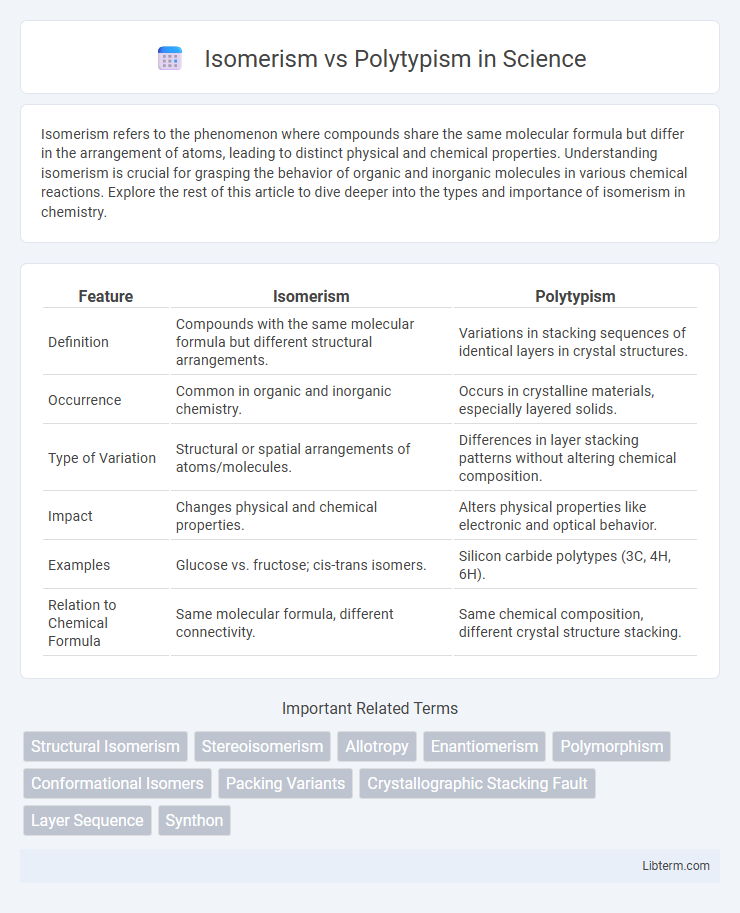Isomerism refers to the phenomenon where compounds share the same molecular formula but differ in the arrangement of atoms, leading to distinct physical and chemical properties. Understanding isomerism is crucial for grasping the behavior of organic and inorganic molecules in various chemical reactions. Explore the rest of this article to dive deeper into the types and importance of isomerism in chemistry.
Table of Comparison
| Feature | Isomerism | Polytypism |
|---|---|---|
| Definition | Compounds with the same molecular formula but different structural arrangements. | Variations in stacking sequences of identical layers in crystal structures. |
| Occurrence | Common in organic and inorganic chemistry. | Occurs in crystalline materials, especially layered solids. |
| Type of Variation | Structural or spatial arrangements of atoms/molecules. | Differences in layer stacking patterns without altering chemical composition. |
| Impact | Changes physical and chemical properties. | Alters physical properties like electronic and optical behavior. |
| Examples | Glucose vs. fructose; cis-trans isomers. | Silicon carbide polytypes (3C, 4H, 6H). |
| Relation to Chemical Formula | Same molecular formula, different connectivity. | Same chemical composition, different crystal structure stacking. |
Introduction to Isomerism and Polytypism
Isomerism refers to the phenomenon where compounds have the same chemical formula but different structural arrangements, resulting in distinct physical and chemical properties. Polytypism is a specific type of polymorphism seen in layered materials, where variations occur exclusively in the stacking sequence of identical layers without altering the chemical composition. Both concepts highlight the diversity in structural forms that materials can exhibit despite sharing the same molecular or elemental composition.
Defining Isomerism: Structural and Spatial Variations
Isomerism encompasses the phenomenon where compounds share the same molecular formula but differ in the arrangement of atoms, classified mainly into structural isomers and stereoisomers. Structural isomers vary in the connectivity of atoms, resulting in distinct molecular frameworks, while spatial variations or stereoisomers differ in the three-dimensional orientation of atoms or groups without altering the molecular formula. Isomerism highlights the importance of atomic configuration and spatial arrangement in determining the chemical properties and reactivity of compounds.
Exploring Polytypism: Layered Crystal Structures
Polytypism refers to variations in layered crystal structures where stacking sequences of identical layers differ, creating distinct polytypes with unique physical properties. This phenomenon contrasts with isomerism, which involves molecules having the same formula but different atomic connectivity or spatial arrangements. Understanding polytypism is crucial in materials science for tailoring electronic, optical, and mechanical characteristics in semiconductors and minerals by controlling layer stacking patterns.
Key Differences Between Isomerism and Polytypism
Isomerism involves molecules or compounds with the same molecular formula but different structural arrangements, leading to distinct chemical properties, whereas polytypism refers to variations in the stacking sequences of crystal layers in a single compound, resulting in different crystal structures without a change in chemical composition. Isomers exhibit differences at the molecular or atomic connectivity level, while polytypes differ primarily in their crystal lattice organization. Understanding these key differences is crucial in fields such as organic chemistry for isomerism and materials science or crystallography for polytypism.
Types of Isomers: Structural, Geometric, and Optical
Structural isomers differ in the connectivity of atoms, resulting in distinct molecular formulas and properties. Geometric isomers, such as cis-trans isomers, arise from restricted rotation around double bonds or ring structures, affecting spatial arrangement without altering connectivity. Optical isomers, or enantiomers, exhibit chirality and non-superimposable mirror images, impacting biological activity and optical rotation in chiral molecules.
Mechanisms Behind Polytypism in Crystals
Polytypism in crystals arises from variations in the stacking sequence of identical structural layers, leading to different crystal modifications without altering the chemical composition. This phenomenon contrasts with isomerism, which involves distinct arrangements or bonding of atoms within molecules. Mechanisms driving polytypism include shifts in layer stacking faults, differences in interlayer interactions, and subtle changes in growth conditions, all affecting the crystal lattice periodicity and resulting in unique physical properties.
Examples of Isomerism in Chemistry
Isomerism in chemistry includes structural isomerism, such as chain isomers like butane and isobutane, and stereoisomerism exemplified by cis-trans isomers of 2-butene. Optical isomerism is another key example, where enantiomers of molecules like lactic acid differ in their interaction with plane-polarized light. Polytypism, distinct from isomerism, refers to different stacking sequences in crystal structures, commonly observed in compounds like silicon carbide (SiC).
Real-World Instances of Polytypism in Materials Science
Polytypism is a specific form of polymorphism where materials exhibit variations in stacking sequences of identical layers, commonly seen in compounds like silicon carbide (SiC) and zinc sulfide (ZnS). Silicon carbide displays over 200 polytypes, each differing slightly in electronic properties and crystal structure, making it crucial for semiconductor and high-power device applications. In contrast, isomerism generally refers to molecules with the same chemical formula but different arrangements of atoms, making polytypism a unique structural phenomenon relevant in crystallography and materials engineering.
Applications and Importance in Science and Industry
Isomerism plays a crucial role in pharmaceuticals by influencing drug efficacy and safety through variations in molecular structures, while polytypism is vital in materials science for tailoring properties of layered materials like silicon carbide and graphite. Isomerism enables the development of targeted medications and agricultural chemicals, whereas polytypism impacts semiconductor performance and catalytic behavior in industrial applications. Understanding both phenomena drives innovations in nanotechnology, electronics, and chemical manufacturing by optimizing structural configurations for desired functional outcomes.
Conclusion: Comparing Isomerism and Polytypism
Isomerism involves molecules with the same molecular formula but different structural arrangements, significantly impacting chemical properties and reactivity. Polytypism refers to variations in the stacking sequences of layers in crystalline solids, affecting physical properties such as electrical conductivity and optical behavior. Comparing isomerism and polytypism highlights that isomerism primarily influences molecular chemistry, while polytypism governs variations in solid-state crystal structures.
Isomerism Infographic

 libterm.com
libterm.com